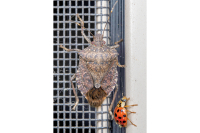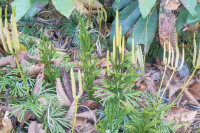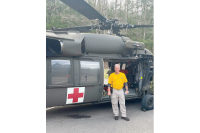Snafu at Cherokee wastewater plant causes cloudy discharge in the Luftee
One month after low oxygen levels killed the bacteria needed to process sewage at the Cherokee Wastewater Treatment Plant, discharge flowing back into the Oconaluftee River is still on the cloudy side as employees work to get the plant fully back online. It’s not clear exactly what killed the bacteria, but the best guess is it has something to do with 8 tons of sand employees removed right around the time the bacteria crashed.
“They had done something and found that a bunch of sand had built up in the splitter box,” said Ken Green, lead engineer on a current project to expand the treatment plant. “We got an excavator in there and dug it out.”
Because the water is gray, not clear, no one had noticed before that where the water was supposed to be 8 feet deep it was only 18 inches deep. But once the sand was excavated, three of the four waste processing units died. The one that stayed alive had been shut off during the excavation because some new components were being installed in it at the time. That led plant workers to conclude that something in the sand likely poisoned the bacteria.
But they’re still working to right the effects. Building the bacterial population back up from near zero isn’t an overnight process, even with hauling bugs in from other plants and using bacteria-in-a-can types of products. That means that the water flowing out of the plant — and into the Oconaluftee River — is not as clean as it should be.
“Basically the effluent was still really cloudy,” said Sarah Schiff, an environmental engineer for the Environmental Protection Agency. “I don’t know what else was technically in there.”
The EPA does not require testing to determine what, exactly, is in the effluent, but the plant keeps its own records as a safeguard against litigation. The plant manager declined to comment for this story, and so those records were not available to The Smoky Mountain News.
Related Items
According to Roger Clapp, executive director of Watershed Association of the Tuckasegee River, tests would determine how much oxygen the organisms in a water sample are using and what amount of fecal coliform bacteria is present.
The biological oxygen demand number is important, Clapp said, because water contaminated with sewage will have a high number of oxygen-consuming bugs, which use up the oxygen that other organisms in a river need.
“They suck up oxygen and then they starve the natural aquatic life of oxygen, and you get a degraded ecology downstream,” Clapp said.
Though not all fecal coliform bacteria are harmful — the term just refers to bacteria that live in an animal’s gut — high concentrations increase the likelihood that pathogens lurk in the water.
Clapp said he’s gotten complaints about unpleasant smells possibly related to sewage contamination and would like to meet with wastewater plant representatives to find out more information.
“I’d like to sit down and talk with them about the condition, what can be done,” Clapp said.
A history of overflows
This isn’t the first time Cherokee has had trouble with its sewer system. So far this year, the tribe has reported 11 sanitary system overflows, which basically means there were 11 times when the sewer system got backed up and sewage bubbled out of where it was supposed to be. Last year, the tribe reported 14 overflows.
“If it hits the water, it’s obviously not good for them,” Schiff said. “There can be all sorts of pathogens in the discharge.”
Raw sewage can cause diseases ranging from mild stomach cramps and diarrhea to hepatitis and cholera, and water contamination can make swimming and fishing unsafe, also affecting aquatic ecosystems. It’s not a good thing, but according to Green, Cherokee’s tally isn’t as bad as it sounds.
“We weren’t very good with our documentation years ago, and we’ve swung the pendulum the other way,” he said.
This year’s 11 spills were localized incidents involving smaller amounts of sewage that either leached easily into the ground or required some minimal treatment, such as an application of lime to neutralize the substance, Green said. Groundwater quality has not been an issue in these spills.
“You have the same thing happening with septic systems throughout the community,” he said. “Septic systems do go through the tank, and after that they go into the leach field. By the time it moves through the ground and through the bacterial map, it starts at the surface and by the time it gets to the groundwater, it’s all cleaned up.”
But last year, Green said, there were multiple times when the river flooded over the top of trench work being done on the sewage pipes. That’s actually one possibility as to where the sand came from — the plant has been struggling with sand issues ever since — and the flooding washed some sewage into the river.
Cherokee’s sanitation standard isn’t necessarily in the clear anyway. The tribe has been under an EPA enforcement action since 2009, when the agency received complaints about overflows.
“As a result of that complaint we went out and did an inspection and found those complaints were valid,” Schiff said.
Being under an enforcement action means that the EPA is keeping a closer eye on Cherokee’s sewage treatment, but 2009 wasn’t the end of its troubles. In 2011, tribal member Linda Lambert filed a lawsuit against the tribe for the overflows she had experienced on her property, listing 17 days spread over two years when raw sewage appeared on her property. The tribe later settled by purchasing her property for $350,000.
However, Schiff said, none of that means that Cherokee is out of the ordinary compared to other systems under enforcement actions.
“Their system is not the worst system we’ve seen,” she said. “It’s kind of in line with other systems with similar enforcement actions.”
Building for a fix
The tribe’s sewage struggles will likely continue for a while, too, because they’re due in large part to stresses on the system from a growing population and casino-related tourism. The original system dates back to the 1960s, and in 1997 the plant had a capacity of just 700,000 gallons per day. That’s when the Harrah’s Cherokee Casino was first built, and the plant’s capacity was expanded to 3 million gallons per day, the current amount, in conjunction with the casino’s construction.
But that’s still not enough.
“The biggest piece of it was the gambling enterprise growing, but at the same time there’s housing and another hotel across the road,” Green said.
Right now, Cherokee is one year into a three-year, $29 million sewage treatment expansion project that will double daily capacity to 6 million gallons and do some repair and replacement of aging lines.
“Inflow and infiltration is a very common problem with aging systems. As the systems get old, the pipes and the gaskets get old and deteriorate,” Green said. “We are the land of aging infrastructure.”
As the project proceeds, new pieces will be installed, increasing the reliability of the system bit by bit. But the capacity of the plant won’t change until the entire project is completed.
“We expect it to run really smooth and really well and handle the high flood level days,” Green projected.













